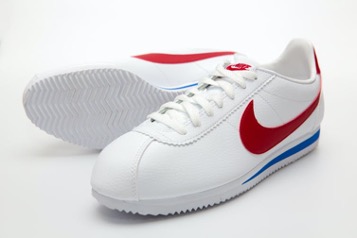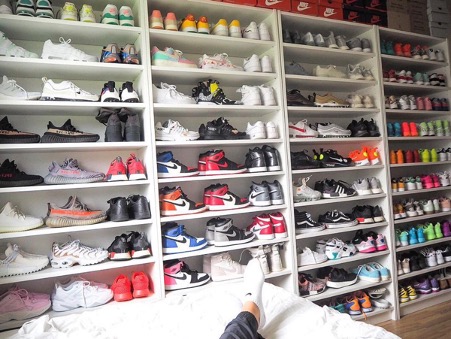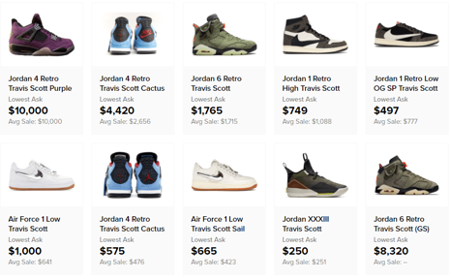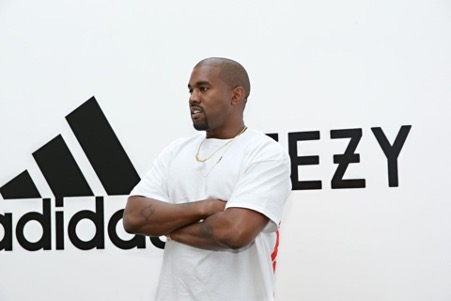Sneakers have evolved from their original function as a display of athleticism to become marketable and fashionable objects of desire. They have become cultural symbols that went from basic commodities to undeniable pieces of fashion.

In 2020, the worldwide sneaker market was valued at roughly US$79 billion, and it is expected to reach US$120 billion by 2026. Moreover, the sneaker industry has progressed to the point that new worldwide exhibitions like the one at the London’s Design Museum, looks at how sneakers have become an uncontested cultural emblem of our time. As a result, sneakers have evolved from a niche item to a highly prized fashion accessory. Footwear is now the most popular product category in the global luxury market, and sneakers have played a key role in this expansion. Furthermore, in the luxury shoe market, high fashion companies such as Gucci and Dior are setting the pace. Dior’s B23 sneakers became the best-selling luxury shoe in 2019 and its appeal appears to be unstoppable.
How did it all start ?
Like said before, the “shoe game” has exploded in popularity during the last ten years. In 2012, just a small percentage of the population was interested in sneakers, and it was considered a niche hobby. Moreover, statistics show that the sector was valued less than $35 billion at the time. Today, by the end of the year, its market capitalization will have more than doubled to $86 billion. It all started with the first pair of sports shoe that was created in the 1830s by John Boyd Dunlop who founded the Liverpool Rubber Company. Decades later, in the late nineteenth century, a period that was marked by industrial advancement and social upheaval, as well as a growing interest in sports, particularly tennis led to the creation of a more specialised sort of footwear, which Dunlop’s rubber sole could provide. In 1929, Dunlop introduced the Green Flash type, which was first worn by tennis legend Fred Perry at Wimbledon. The Converse All Star, which was created for basketball, was another notable 20th-century sports shoe.

Adidas and Nike, on the other hand, have moulded the sneaker’s transition from sport to style. These two brands are the main actors of this “hype” around sneakers. For a little bit of history,
Adi Dassler established the company in Germany in 1924 as “Gebrüder Dassler Schuhfabrik,” which was subsequently renamed Adidas in 1949. Jessie Owens wore the first track shoe designed by the brand with a full leather sole and hand-forged spikes at the 1936 Berlin Olympics.
Bill Bowerman and Phil Knight founded Blue Ribbon Sports in 1964, which later became Nike Inc. in 1971. This corresponded with the running craze that swept the United States. The Cortez, a cushioned running shoe, was Nike’s first commercial product. The brand’s cultural prominence was cemented when Tom Hanks wore the Cortez in the six time award winning Oscars movie, Forrest Gump.

The emergence of the “hype era” :
The 1970s were characterised by an underground sneaker culture and the rise of hip-hop. As an example, Adidas’ Samba design became a prominent aspect of Terrace Fashion within the football fan subculture. Run-DMC released the song My Adidas in 1986, which led to a sponsorship arrangement with the brand. This cemented the sneaker’s indelible role in pop culture. But it’s only in the 1980s that sneakers the phenomenon began. The release of Nike Air Jordan’s resulted in the commodification of sneakers and their appeal as status symbols, which was fuelled by celebrity or athletes sponsorships and endorsements.

All thought sneakers were always considered as items that can make a fashion statement and make a person look cool or fashionable, it’s only by 2010 and the digital age with sneaker marketing and resell culture that the sneaker market exploded and created this hype around it. The expanding number of “sneakerheads” who collect and trade shoes has helped to sustain this “hype cult status”.
Limited edition sneakers featuring a celebrity, hip-hop artist, or athlete are regularly released by Nike and Adidas. It is not uncommon for people to go to great efforts to obtain these rare models, even if it means queuing all night or spending crazy amounts of money. The price also generates this hype around sneakers, the more expensive a shoe is the more hype it is and the other way around works, the more hype a shoe is the more expensive it is.
These sneakers usually have a retail value between 140£ to 250£ in very exclusive drops but they can be reselling for thousands of pounds. The lucrative sneaker resale industry has spawned a new cult of sneakerheads who are creating major buzz and personal profit through their entrepreneurial drive. Sneakers are the most popular footwear in the world, from sports to fashion. Despite their general acceptance, sneakers maintain their appeal as cultural symbols.

What’s a sneakerhead ? And 5 signs you might be one :
Individuals that collect, trade, and/or admire sneakers are known as sneakerheads. The majority are educated about the history of sneakers and are really passionate about anything in relation with sneakers or streetwear. Sneakerheads were regarded to be a craze group that indulged in excessive shopping habits when they first appeared on the scene. However, due to the sale and resell activity within the sneaker community, sneakerheads have had such a financial impact on the industry over the years. Sneakerheads seek out limited-edition sneaker collections and celebrity partnerships, which generate a sense of exclusivity and hypeness amongst them. As a result, buying behaviours, as well as unique norms and customs, are engendered inside the Sneakerhead community.
Sneakerhead culture started in the late 1970s/early 1980s when streetwear became linked with footwear, and iconic shoes like the suede Puma Clydes, Adidas Shell Toes, and Converse Chuck Taylors made their debut. Nonetheless, the 1985 release of the Nike Air Jordan 1s is credited by a huge majority of Sneakerheads as their introduction to the sneaker culture. The shoe earned prominence as a result of its association with Michael Jordan, arguably one of the most popular athletes of all time. Since its debut in 1985, the Air Jordan series has grown in popularity and now accounts for more than half of the basketball shoe market. The series now features multiple collections or “shoe drops” since 1985, and more than 100 million pairs of Air Jordans have been sold.

What makes you a sneakerhead ?
- You wait impatiently for every release and you are willing to spend a night out to queue for a pair.
- You have paid more than retail price for a pair of sneakers
- People usually tell you that you have a “shoe problem”
- You clean every pair that you own after wearing it
- You follow more than ten sneaker pages on social media

The reselling business : Too much ?
Sneakers nowadays sell for a lot of money. They have gained great popularity, but it took a few distinct fads to reach to the point where people are willing to spend hundreds, if not thousands, of dollars on them. Celebrity partnerships, a more casual society, and astute shoe releases have all fuelled demand for high-end, high-quality sneakers.
Sneakers can sell and resell for a lot of money, whether they’re on the auction block, in the store, or in the hands of resellers, their price can skyrocket very fast depending on the hype around them. Some Air Jordan’s for example can fetch up to $2,000 on the reselling market when they only retail around a price of 160$. A Canadian investor paid $437,500 for a pair of extremely rare diamond Jordans.The hype, on the other hand, is still at an all-time high. Everywhere in the world now days, sneakers have become the “ultimate prestige symbol.” Certain exclusive collaboration and “drops” led even sometimes to violence and mayhem as the crowd tried to get their hands on the shoe before everyone else.
Several industry professionals try to understand why people are willing to spend hundreds of dollars on a new pair of shoes. The advent of sneaker culture, the mainstreaming of casual wear, and shoemakers buzzy releases have all been highlighted as contributors in the increased price of sneakers.

Furthermore, non-athlete influencers’ continuous contributions to the sneaker business have helped breathe new life into the increasingly “stagnating storytelling” that athlete-focused sneakers had relied on. Entertainers can tap into a larger fan base, and they’ve helped elevate the status of sneakers by turning the focus away from performance and toward style and “coolness”. A fan of a professional basketball player may be drawn to a shoe’s design or durability on the court, but someone who idolises Kanye West or Travis Scott’s fashion sense is more concerned with what their sneakers express to the world. Some of these collaboration sneakers can today go for thousands of dollars in the reselling market.



Great work and a very good explanation about the origin of sneakerheads and the hype about sneakers !
Pretty nice report
Well done Ghita
That’s so interesting to know more about the story behind sneakers !
It’s well written !
Good job
the early fashions of sneaker were promoted essentially by rappers and basketball players
Rare to find and article detailed that much, thanks!
Your report is summarizing the enthusiasm of people on snickers phenomena well done
Great!
Good job, thank you for this detailed detail to know the origin of shoes and their value and how they have evolved over time
Very interesting. I miss my 2006 jordan
loved reading this article !
it’s very well written, Good job 👏🏼
Fire read, Very insightful take on the sneaker industry !
Awesome !
I really enjoyed reading this very well written article
Great report !!!
Very informative
Good job, thank you for this detailed detail to know the origin of shoes and their value and how they have evolved over time
topic of the hour!! An amazing report that sheds light on the phenomenon of the rising generation’s obsession with Snickers !
Good job
Great blog…very informative.
Extremely brilliant and informative article , looking forward to read more interesting stuff from you ! Keep up the good work
Great analysis
It’s very interesting and catchy !
Best of luck 😊
Great article!!
Whatever influencers have, everybody wants !
Very well written and interesting article 💯👏
A very very good job!!! well done !!
Very Enlightening article ! Big like !!! Can i share it on my linkedin ?
Definitely, thank you so much for the feedback !
Yes I agree with you!
The influence created around the entire industry plays a major and vital wrote.
I really enjoyed reading this!
Interesting report. Good job
interesting research. I didn’t know how big this business was, very much into the fashion world.
There seem to be good business opportunity.
Thanks for the nice work.
good job and good luck
Great job ! Thank you for this report ! Super interesting to know more about the story of sneakers.
Good report, clear, concise, and complete, Well done Ghita….
Expecting in your next report more deep dive onto the areas of strategic management, pricing strategy that evolves over the years…..Keep it up.
Thank you for your feedback, I’ll make sure to take note of it for next time !
Very informative and instructive report. Aligned with the fashion 2022 tendency
Well done
Great insights. It’s astonishing how “commodities” become collectibles and items of value…
Good job
Amazing report and clear language . I had fun reading it. Great job.
Good job
This is a very interesting blog about Sneakers. Well done Ghita!
Great work ! Astonishing article, very useful and helpful ! Thank you Ghita !